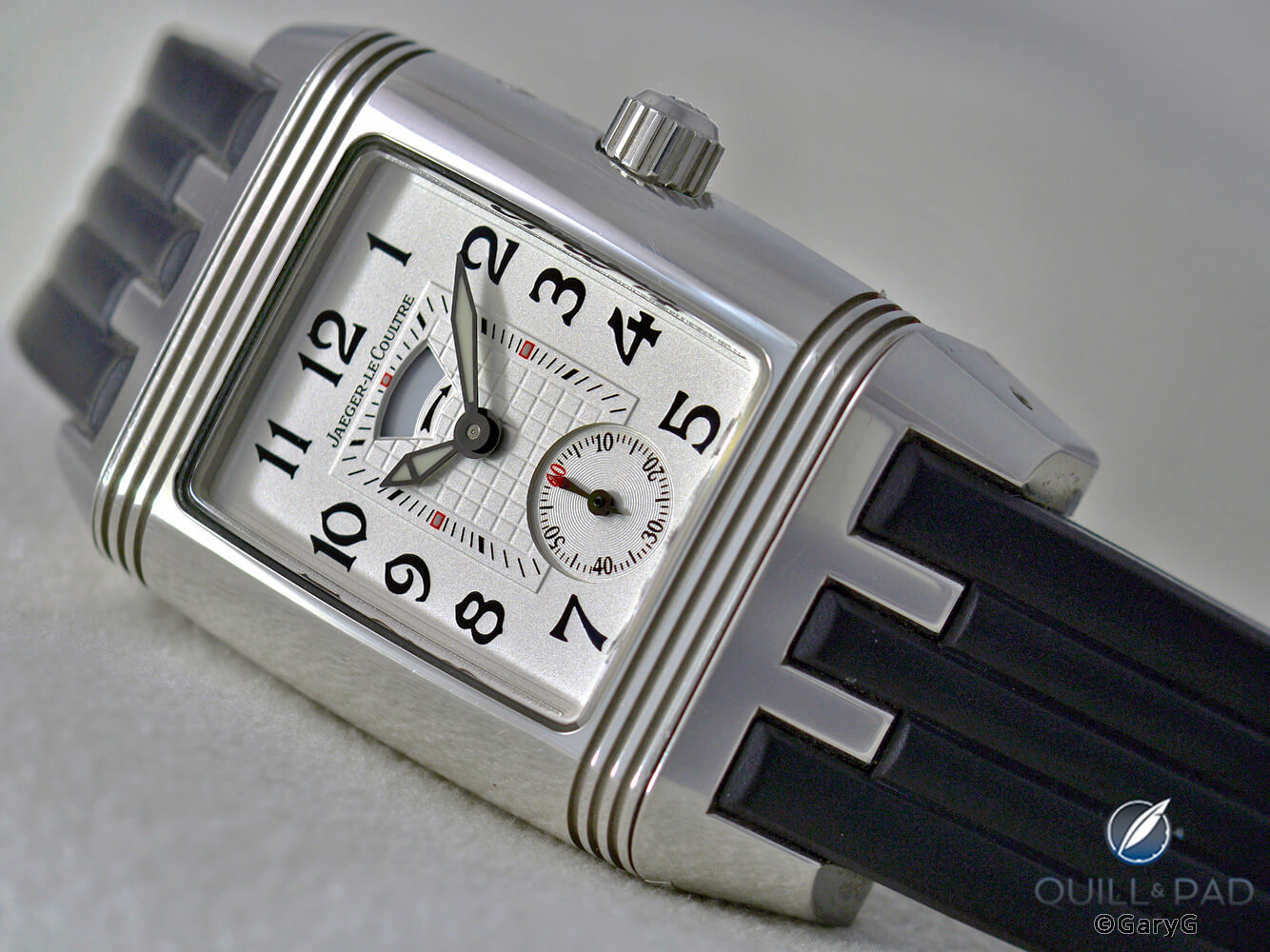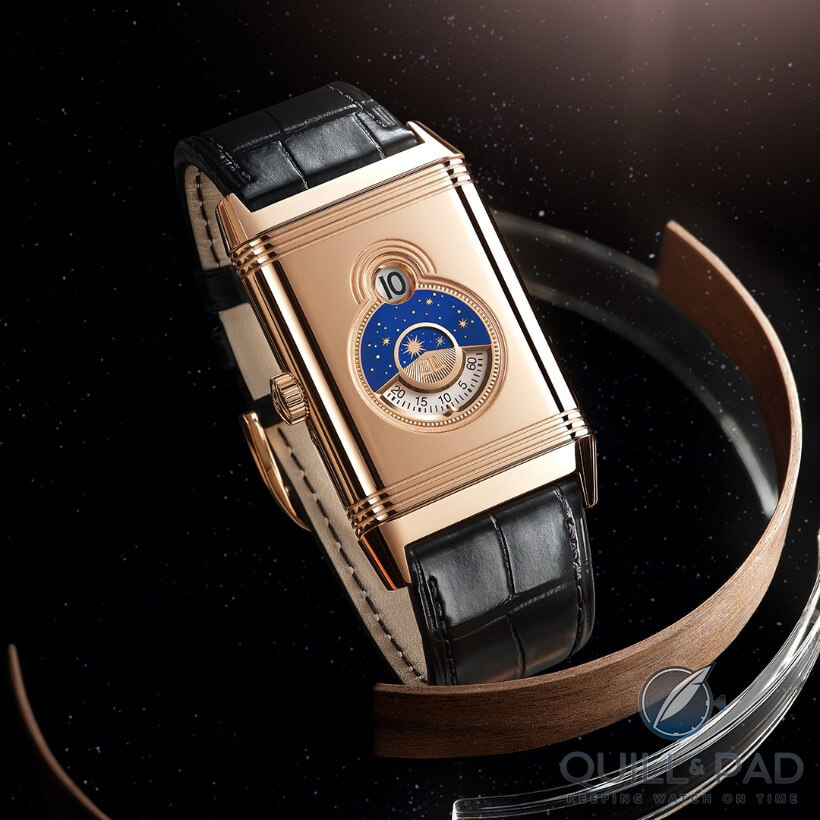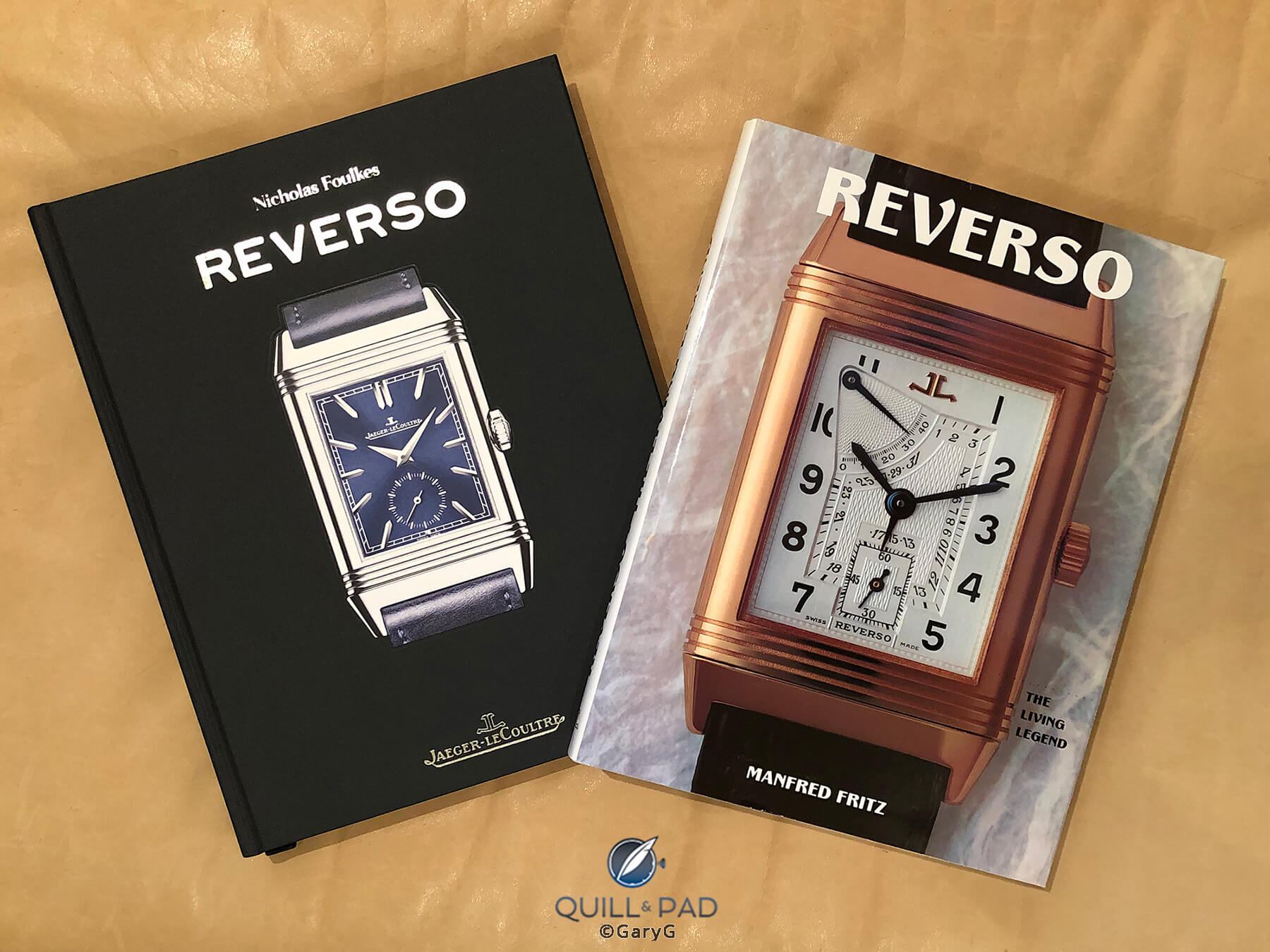Why I Love The Jaeger-LeCoultre Reverso – And You Should Too
by GaryG
If there’s a term I hate hearing thrown around when it comes to watches, it’s “iconic.” There are others, of course: DNA comes immediately to mind – but if every so-called iconic watch were truly a lasting standard, we’d be awash in museum pieces. Even the Grand Prix d’Horlogerie de Genève feeds into this silliness with its Iconic category, the limitations of which I’ve commented on in one of our 2021 GPHG panel discussions.
To every rule, however, there are exceptions: in this instance a small group of individual references and watch families that are instantly recognizable, remain fresh across the decades, and succeed on both functional and aesthetic grounds.
I’m here to argue that the Reverso by Jaeger-LeCoultre is among them.

Prime example: the author’s Reverso Grande Taille GMT shown with a bit of photo wizardry
All superheroes have origin stories
The legend surrounding the Reverso is that in 1930 a group of British army officers based in India sought a watch that would stand up to the shocks associated with their chosen sport of polo. Swiss businessman César de Trey then carried that request to Jacques-David LeCoultre, who in turn commissioned Jaeger S.A. and designer René-Alfred Chauvot to create the Reverso-style carriage-and-body case style patented in 1931 and still in use today.

Replicating a legend: Tribute to Reverso 1931, 2012 U.S. limited production version
Is this origin story completely factual? We’ll never know, but to quote the famous line from the film The Man Who Shot Liberty Valance, “When the legend becomes fact, print the legend.” It’s an appealing and plausible tale, and the original watch, reprised in modernized form in 2011 and 2012 and shown in the photo above, was a triumph of Art Deco styling. It featured minimalistic dial design, stylized font, and the three carved gadroons at the top and bottom of the rotating body that have become so familiar today that we barely see them.

Regardless of complication, obviously a Reverso at first glance
Is the form of the original Reverso so distinctive that even its proportions must remain constant? Opinions vary on that. For me, there have been some successful attempts to play with the exact shape and dimensional ratios of the Reverso case, including the Reverso One, some examples within the Gran Sport line, and some flops, including the square Squadra cases.

Triumph or tragedy? DrMrsG’s Reverso Duetto Gran Sport
It takes more than a recognizable look to make a watch an enduring icon, though. Some of the other reasons I believe the Reverso merits this distinction are as follows.
Versatility: While at times I’ve been concerned that Jaeger-LeCoultre offers too many variations of the Reverso, and it seems that every few years there’s an announced rationalization of the line that is then followed by predictable proliferation, for me the sheer variety of Reverso watches is evidence of the design’s robustness.
There are of course still the very simple single-faced pieces with solid backs, but over the years we’ve seen everything from dual-time watches to tourbillons, chronographs to repeaters, and even grand complications – all in the same familiar form.

The author’s Jaeger-LeCoultre Reverso Répétition Minutes
Ingenuity: Making a minute repeater in rectangular form with shaped gongs and in the size of a Reverso case is no small feat! Legendary constructor Eric Coudray accomplished the task and managed to make the chiming resonant in a caliber that inhabits one of my favorite watches, the Reverso Répétition Minutes. This watch serves as the foundation for all the Reverso repeaters that have come since.
And speaking of ingenuity, at the far reaches of the imaginable we have the Reverso Grande Complication à Triptyque and the 90th anniversary-celebrating Hybris Mechanica Caliber 185 Quadriptyque, which respectively utilize three and four separate surfaces to delight us with a dizzying range of temporal, astronomic, and aural complications. I really wish I’d been in the JLC conference room the day someone said, “Hey, couldn’t we use a pushpin from the case to the carriage to activate a calendar in the carriage?” Only the unique design of the Reverso permits anything from a one-surface to four-surface display.

Four surfaces, all in use: Reverso Hybris Mechanica Caliber 185 (photo Jaeger-LeCoultre)
Even “simpler” Reverso complication pieces, like the original Duo that was my first Jaeger-LeCoultre watch and the Grande GMT that replaced it, are pretty astonishing once you study them a bit. Let’s take the GMT: on the front, we have hours, minutes, and small seconds along with a big date display and day-night indicator. On the reverse, seen below, we have hour and minute hands that revolve in the opposite direction from the hands on the front of the watch, a display of the local time zone relative to GMT, and a second day-night display, this one for the local time. Oh, and tucked up in the corner? An indicator for the mind-blowing eight-day power reserve.

Multiple indications, small volume: reverse of the GMT Grande Taille
Evolution: While the Reverso has its Art Deco design codes as a partial antidote to aging, I’m sure that it would be much less relevant today had Jaeger-LeCoultre management not continued to evolve its identity. Not all these experiments succeeded, but for me, then-president of Jaeger-LeCoultre North America Philippe Bonay unleashed a masterstroke with the U.S. edition of the Tribute to Reverso 1931.
You can like the slight fauxtina on the indices or not, but the idea of a faithful recreation of a notable historical watch in limited quantity with tasty extras like a cordovan strap from polo boot maker Casa Fagliano was a trendsetter in the vintage revival movement that many, many brands have joined over the following decade.

Everything old is new again: Tribute to Reverso 1931 on the wrist
More recently, we’ve seen several evolutions of the Duoface design, including a variety of colors, dial textures, and fonts along with simple single-face, two- and three-hand Reversos in a wonderful array of colors from burgundy to a subtle green to a vivid blue (with an accompanying Fagliano strap) that I’ve been oh-so-close to buying any number of times.

Simple three-hand Reverso with brushed vivid blue dial
Inclusive appeal: We’ve heard a lot recently about the topic of gender and watches; what, if anything, is a “woman’s” watch or a “men’s” watch, and at an extreme, should gender distinctions even be used in this category?
I’ll leave that larger debate aside for now, but when I think of a watch whose appeal spans the sexes, it’s the Reverso. Jaeger-LeCoultre goes so far as to use the term “androgynous” on its website; perhaps not the word I would have chosen, but I think it’s more than fair to classify the Reverso line as a “crossover” phenomenon in the watch world if ever there were one, with credible pieces suited to both small and large wrists in sober and blingy variations, plus a healthy dose of individual references wearable by just about everyone.

Reversos for everyone: rectangular Jaeger-LeCoultre and LeCoultre watches in the GaryG household
Personalization: At least with the simpler Reversos there’s also the possibility to add a highly personal touch to the blank metal back side of the case; closed case backs suitable for engraving seem in short supply these days, and even less those that can be shared at one’s whim simply by flipping the case over with the watch still secure on the wrist.
Only one Reverso in our house has been engraved so far, and that with a single initial in JLC’s signature Art Deco style. But from time to time I do stare at the blank backs of a couple of my Reversos and try to imagine how a suitable personalization would appear.

Engraved case back, small Reverso Classic in yellow gold
Broad appeal: One of the great things about our hobby is that enthusiasts have strong views! One person’s grail is another’s trash. My experience over the years is that a Reverso is a welcome sight at any watch gathering. Not everyone owns or would buy one, but lots of folks have at least one and no one is going to doubt your taste if you show up with one of these rectangular treasures on your wrist.

Always welcome: group wristshot of Reverso enthusiasts
Thoughtfulness and integrity: I think of Jaeger-LeCoultre’s watches overall as being very honest pieces that provide real value for what you pay; if a dial is stamped rather than hand-turned or the movement concealed behind a solid back or second face isn’t gorgeously finished, there’s no pretense that anything is otherwise.
For me, the best evidence of this attribute is in the shapes of the movements developed by JLC over the decades for the Reverso. One of my pet peeves is a round movement in a shaped case, and while many of the Reverso movements are oblong with surrounding inserts rather than purely rectangular, they are indeed shaped rather than round.
Accessibility and aspiration: It’s not easy to have a single product line that spans all the way from entry-level pieces to multimillion-dollar halo watches, but JLC has achieved it with the Reverso. It’s still possible for a young collector to do exactly what I did almost 30 years ago and enter the world of true high horology with a first Reverso purchase. At the same time, there are pieces that I still drool over and hope at least to see in person.

Fortune smiles: the author wearing a friend’s Reverso Gyrotourbillon 2
The present and future of Jaeger-LeCoultre Reverso
One of the tough things about being the steward of an icon is that while you need to keep the offering fresh, you need to have many more hits than misses as you extend the line.
In recent times, the ninetieth-anniversary Quadriptyque and newly launched Tribute Minute Repeater, the latter with an update on the original Caliber 943 Reverso repeater movement that adds refinements including a silent regulator and trebuchet hammers, are solid winners.

Winner, winner: Reverso Tribute Minute Repeater, 2021 (photo Jaeger-LeCoultre)
I was initially enthralled as well by the Reverso Nonantieme with a jumping hour and rolling minute display cloaked in an otherwise closed case back in true polo-protection tradition. But much to my chagrin the “jumping” hour was more of a creeping-to-12 arrangement, which was both a technical and practical disappointment as it makes discerning the actual hour a bit of a chore. I’d dearly love to see this piece retooled with a true jumping indication and would be at the front of the line to buy one if that minor miracle somehow came to pass.

Not quite jumping: Reverso Nonantieme, 2021 (photo Jaeger-LeCoultre)
Conventional wisdom has it that “people don’t buy rectangular watches.” As a longtime Reverso enthusiast and owner, I’m glad that Jaeger-LeCoultre continues to defy the naysayers. And with the ongoing energy in the watch market for vintage looks, I suspect that with strong continuing stewardship the Reverso will see its hundredth anniversary in 2031 healthier than ever.
Don’t trust me? Read the book!
Actually, books! My final argument for promoting the Reverso to iconic status: the two comprehensive histories of the line. The 1990s book by Manfred Fritz takes us through the sixtieth anniversary of Reverso and the introduction of the first truly complicated watch in the line, the Reverso 60th, while the lavish new book from Assouline, penned by watch historian and current GPHG jury president Nick Foulkes, takes us from the very beginning through the current day with beautiful photos and superb quality printing to boot.

Not one book, but two: histories of the Jaeger-LeCoultre Reverso
Do you see the Reverso as a classic? Let me know in the comments below and feel free to share your own stories of Reverso acquisition, ownership, and personalization. I’ll look forward to hearing from you. In the meantime, happy wearing!

Parting shot: Jaeger-LeCoultre Tribute to Reverso 1931, U.S. limited production version, 2012
Quick Facts Reverso Tribute Minute Repeater
Case: 51.1 x 31 x 11.41 mm , pink gold; front and rear sapphire crystals with integrated indices; integrated slider for minute repeater actuation
Dial: skeletonized front dial and partially open rear dial with Geneva stripes; silvered hands on front and pink gold hands on reverse
Movement: manually wound Caliber 944; 35-hour power reserve; 21,600 vph/3 Hz frequency
Functions: hours and minutes on two dials, minute repeater
Limitation: 10 pieces
Price: €250,000
Production year: 2021
You may also enjoy:
90 Years Of The Jaeger-LeCoultre Reverso
Why I Bought It: Jaeger-LeCoultre Tribute To Reverso 1931
Jaeger-LeCoultre: A Collector’s ‘Gateway Drug’ And Ongoing Pleasure
Why I Bought My Wife An Engraved Jaeger-LeCoultre Reverso Classique
Leave a Reply
Want to join the discussion?Feel free to contribute!



“what, if anything, is a “woman’s” watch or a “men’s” watch, and at an extreme, should gender distinctions even be used in this category?”
PLEASE don’t start that nonsense!!!
“ It’s still possible for a young collector to do exactly what I did almost 30 ”
Can we PLEASE dispense with the idea that a watch costing “a mere $4,000” is for “young people” who haven’t made any money yet?
For 90% of First World citizens this represents an extravagant purchase. If you don’t know that, you should take a look outside your tennis club.
I do not resent your success or your collection Gary. But please please please stop pretending that it is normal to have “a few Reversos” lying around the house. Just take stock of the World, eh?